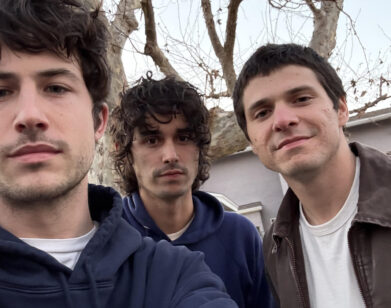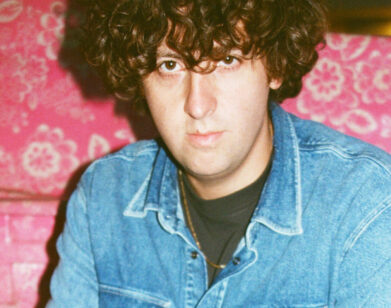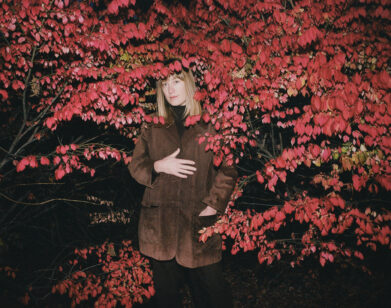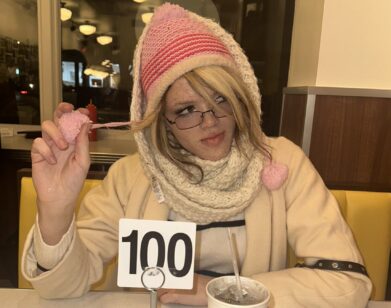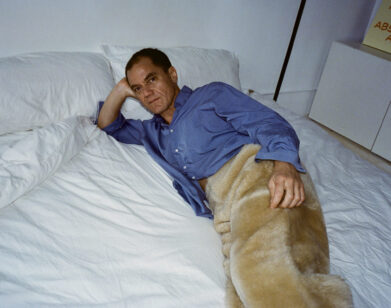MNDR, To Her Own Beat
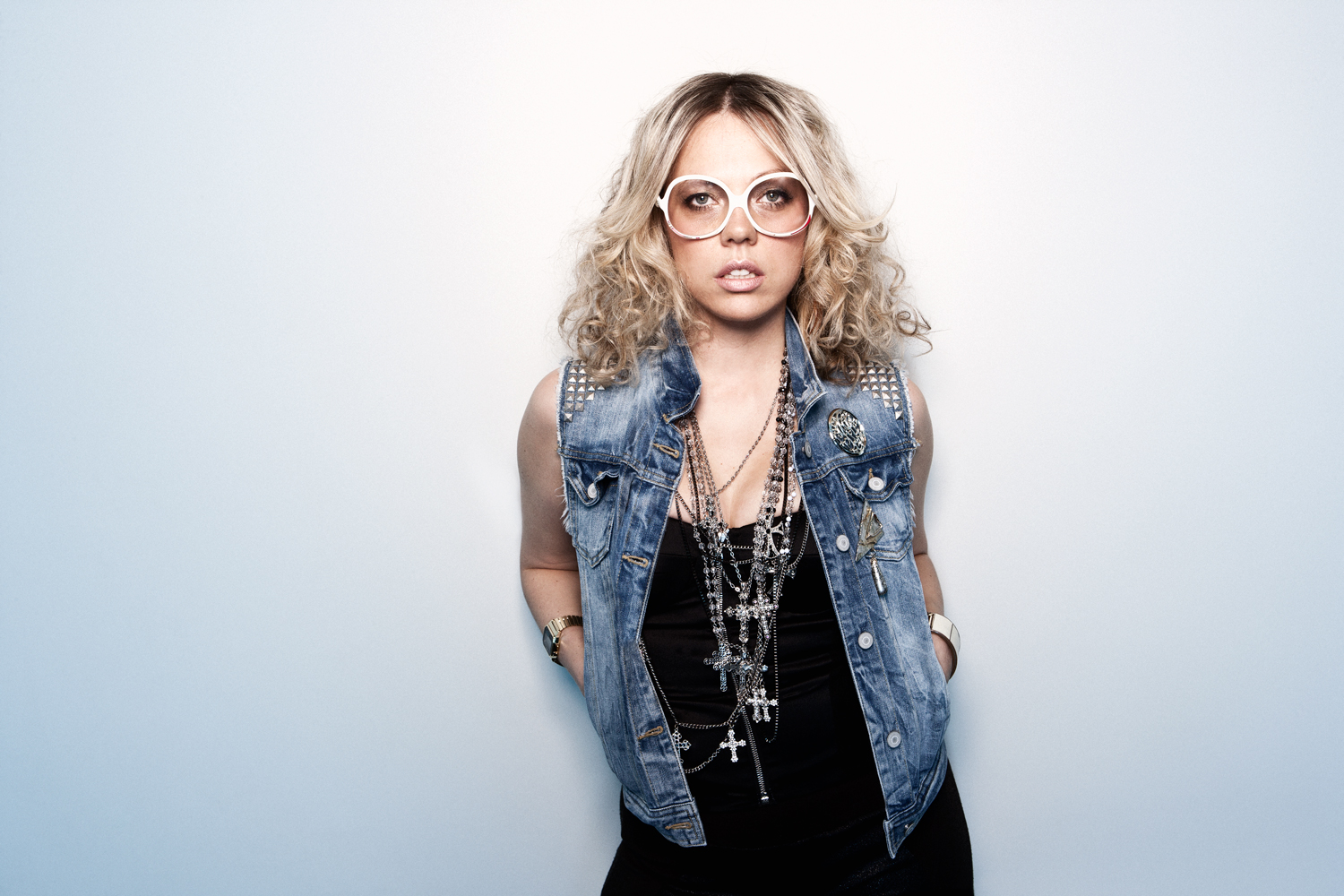
ABOVE: MNDR
It takes an effortlessly cool tenacity to wear a wardrobe like Amanda Warner’s. She mixes it up with mismatched ensembles of designer shorts and ratty tees, but Warner’s style staples are her array of modish eyewear and her head of thick, blonde, “always kind of fucked-up” hair. With her songwriter’s mind bouncing between international politics, civil wars, and the evolution of pop, finding a blow dryer and brush is the least of her worries.
Warner is the frontwoman of New York-bred techno-pop duo MNDR. She notes modern musical acts like Charli XCX, Lorde, and Grimes as heralding in an era of gifted, unconventionally badass pop divas—leaving herself off the list, an omission we’re happy to correct. In the last year alone, she and MNDR producer Peter Wade have penned over 130 songs—some for themselves, others for international pop acts like Kylie Minogue and Sean Paul. Also on the international stage, MNDR currently has a hit single, “Rydeen,” with Japanese girl group E-Girls; and “Let Go,” with RAC and Kele Okereke, is set for international release April 1. Apparently, Warner prefers the studio to sleep.
MNDR is headlining at Brooklyn’s Glasslands Gallery this Friday, March 28. Special guests include dancers FLUCT, vocalist Steven Klavier, and projection artist Jamie Carreiro. In anticipation of the show, we spoke with Warner about her “young adult” years in artist communities, finding inspiration in Archimedes, and why she expects to get sued any day now.
BENJAMIN LINDSAY: First off, what’s the occasion for the show at Glasslands? It’s been some time since you released Feed Me Diamonds; do you have anything new to showcase?
AMANDA WARNER: I do, I have a lot of new music. I have some music in Japan that just came out, some new features. I’m beginning to do a lot in the Asian market—the Japanese market and Korean market—so nothing in the U.S. as of right now. The “Let Go” single that I did with RAC featuring Kele from Bloc Party, [its] international release is on April 1. My next single, “Burning Hearts,” we’re going to be launching the video in April, and I’m really excited about this video because it has a lot of controversy in it, which sounds really cheesy, but we basically did a video in a place we couldn’t do a video, in a very public place. I took a gamble. I’ll probably have a lawsuit, but it’s fine.
LINDSAY: Just bracing yourself for a lawsuit, then?
WARNER: Yeah, that’s what’s gonna happen, but I’m so excited about it.
LINDSAY: I’ve noticed that you definitely have a group of artists that you consistently work with over the years. Do you find that collaborating with people like Jamie Carreiro or Cody Critcheloe enhances your own vision as an artist?
WARNER: Yeah, I think that just because I’ve been sort of participating in art throughout the U.S., like, underground art communities for all of my young adult—late teens, young adult, whatever you wanna call that—life, you build these friendships through supporting each other’s art. Being a part of those communities through the U.S. and Europe, it’s kind of natural and not a really forced thing. As I progress with [MNDR], I notice that I’m pulling in these people that I’ve known for years and building on these concepts and building a team around it.
LINDSAY: Have you ever had to compromise your vision along the way?
WARNER: Without sounding smug, I really feel like MNDR is a new generation of music that functions completely out of label systems. [My] fan engagement is a one-on-one experience, not, like, a one-going-through-record-labels, which is not always intentionally what I want, but it’s just sort of the journey of this project as of now. I’ve never done something I didn’t want to do with MNDR, but that’s never been my ethos of, like, “MNDR won’t take shit from anyone! MNDR’s here to break everyone’s boundaries of pop music!” You know, I think I’m just hopelessly me, and I can kind of be goofy and awkward, and I can’t be any other way.
I think where I have fumbled is when my career started to take off sort of without me setting out to have a solo career. Especially at that time in 2010, it was a very Lady Gaga, Katy Perry… everything’s perfect, you’re perfect, like, a very real idea of music, and it was great, but I think I had trouble getting record deals because I just cannot do that. And now I love it because of the success of, like, Charli XCX and Grimes on the major labels with these irreverent female artists who aren’t really playing those games. And Lorde. It really makes a world where I feel more natural. I’m not a model. I don’t do that surreal manicured thing, but I really admire it. It’s very difficult to do that.
LINDSAY: I don’t think it’s by coincidence that all the artists you just named as changing the industry are female musicians. Do you feel that this is kind of a time for those strong, unique female voices to break through and have a role in the mainstream?
WARNER: Yeah, it’s been absolutely awesome. Right now, it’s really exciting because that sort of surreal, unrealistic fantasy world of pop culture is done. And now we’re in these areas that are redefining sexuality and redefining women’s roles and redefining what’s art and what’s good and what’s not. And really, the fans are driving it, not so much the record companies. The fans have better taste than the record companies think they do. Music lovers are not dumb; we like good music.
LINDSAY: Between fashion, music, writing, and whatever other hats you wear, do you have one that fits best?
WARNER: I love to be in the studio. Like, I got invited to three barbeques today, and I’m gonna finish three songs today instead. I absolutely love it; it makes me so happy. I love writing songs at the piano, I love writing songs with a guitar, I love writing songs by the beat. That’s where I feel comfortable. It’s the purity of the art form.
LINDSAY: Thematically, what parts of your life influence your songwriting?
WARNER: World politics really influence my writing. I’m really passionate about civil wars. Not, like, the Civil War with a fiddle and a period piece, but, like, a war within your country, within your culture. I just feel like there’s so much emotion in that. You can start with that emotion and sort of dress it up in different ways so it can be understood in different ways, but sometimes you just need to tap into raw emotion, and that emotion can be based on war, based on love, based on the Internet, you know, whatever’s going on. Recently, Archimedes—I went to go see a retrospective of Archimedes, and I’m reading his book.
LINDSAY: Oh really? That’s not really typical pop-music fare.
WARNER: No, we’re not in the club.
LINDSAY: Why the interest in your Japanese audience right now?
WARNER: For me, and for the career I want as a producer and as a writer and as an artist, I want to be international, and I want to not be in that album cycle or “what are you promoting?” cycle. This year, [it’s been] a constant stream of content. As an artist, it gives me the flexibility that I want and it allows me to feed a lot of content to my audience and build an audience.
LINDSAY: If you’re looking to have that breadth as an international artist, that’s kind of necessary to have that constant stream. I mean, you say that you’re happiest in the studio, so I’m sure you’re thrilled to be as busy as you are.
WARNER: I’m thrilled, for sure. Over exactly 12 months today, I’ve written 130 songs. We’re really going to move out of the album cycle. I don’t want my projects to be associated with that. I’m not against albums, just, like, “Let me stop everything I’m doing and write another album.” To me, the artists that are the most exciting right now are Sia or Charli XCX and people who are writing and featuring and writing and featuring and they’re everywhere. Every six weeks, they have something coming out. That’s the music 3.0.
LINDSAY: I mean, if you look at the way music and media is consumed today, everything is streaming. People aren’t buying full albums, they’re looking for that constant content. Not to be dramatic, but it’s kind of representative of the death of the album. It’s rare that a fully realized work is released from any particular artist. Not that that’s a problem, it’s just a shifting plain.
WARNER: I mean, I just figure if you’re a musician, you’re making music every day. Why not put it out?
LINDSAY: Your campaign with Kmart—how did that come about?
WARNER: As a campaign, they’re launching a new clothing brand about clothing yourself. Not to use a buzzword, but normcore. That’s, like, my personal style and what I believe. I’ll go to Kmart and get a jacket and get it relined and make it my own. So we talked about my fashion ethos, which I would describe as high-low. I’ll think it’s funny to get Kenzo shorts, but put with it my Cramps T-shirt that I’ve had for 10 years with holes all over it.
CATCH MNDR THIS FRIDAY, MARCH 28, AT GLASSLANDS GALLERY. FOR MORE ON THE ARTIST, VISIT HER WEBSITE.

